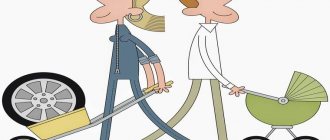Popular wisdom says: “Five minutes of healthy laughter are equivalent to a glass of sour cream.” Let’s leave aside for now the question of sour cream, is it always good for everyone, but as for healthy laughter, there are certainly no contraindications! But what is healthy laughter? We know that laughter can be different both in form and content: cheerful and carefree or mocking and poisonous; sonorous and loud or quiet and muffled; natural and sincere or artificial and affected, etc. (Or like A. Raikin: “...and also from tickling”). Laughter expresses and evokes a wide variety of feelings and moods. And by how and when a person laughs, you can tell a lot about him. In a certain sense, laughter is our calling card. In particular, a fool is recognized by laughter (they say, “laughter for no reason is a sign of a fool!”). Therefore, laughter is quite a treacherous thing, isn’t it?
Types of laughter or “Who are you laughing at?”
Psychologists distinguish five types of laughter.
First type: laughter - a (ha ha). This is a completely open, relieving laughter, full of agreement with the outside world; it can characterize a naive and cheerful disposition; wonderful, carefree mood; optimistic attitude and positive attitude towards people and the existing problem.
Second type: laughter - on e (hehe). This is not a very nice laugh, reminiscent of something bleating, sometimes impudent or envious. Moreover, the more open the vowel, the more schadenfreude and contempt are expressed. Such laughter always maintains a certain distance between people.
Third type: laughter - on and (hee hee). This is not a relieving laugh “from the inside out”, but a giggle that goes deep into oneself; a mixture of irony and malice, secrecy and cunning, with implicit subtext and intent.
Fourth type: laughter - on o (ho-ho). Such laughter sounds boastful or threatening, with some surprise, doubt or criticism, sometimes mocking or protesting.
Fifth type: laughter - woo (hoo-hoo). This is no longer real laughter, but rather fear, timidity; it can characterize the desire to hide internal tension and insecurity, and sometimes panic.
(Try to test all five types of laughter for yourself, quite interesting!)
Of these five types of laughter, the healthy one is the first, which expresses joy and pleasure, a sincere and natural reaction to something funny. Such laughter can sound loud and quiet, loud and dull. These are already properties of our temperament, vocal cords, as well as the situation, etc.
The healing effects of laughter therapy
Considering these and other factors, it is time to approach laughter and positive emotions as medicine. Indeed, the healing properties of laughter therapy are effective. It has long been recognized by Japanese doctors. Studying the quality humor familiar to all people, they came to the conclusion that laughter has a positive effect on:
- heart muscle;
- endocrine system;
- breath;
- immune and nervous systems;
- relieves pain from rheumatism.
In addition to the fact that laughing is pleasant, it turns out that it is very useful.
About the volume of laughter or “Laugh, laugh loudest ...”
It is believed that loud laughter is indecent, unaristocratic, unaesthetic, and simply unintelligent. Probably many of us have fully experienced all this criticism ourselves.
“Where is the solidity?” - our teachers invariably told us back in school (isn’t it true, since then this word - “solidity” - for some of us has become a common noun, associated with something mothballed and hard? It’s not for nothing that solid is translated from English as solid!).
But even as adults, some of us sometimes have to hear: “It’s not respectable to laugh like that, you’ll lose your authority!” But many of us, fortunately, have never learned to laugh “into our fists.” After all, sometimes it is loud laughter that is a “lifesaver,” cooling, for example, an overbearing bureaucrat or a militant fool, and sometimes simply defusing a situation that is too serious (to the point of boring!).
Conclusion
From now on, forget about the adult wisdom “laughter for no reason is a sign of a fool” - we now know that we have more than enough reasons to laugh. Once you look around for something funny, the world around you will magically change. The main thing is “smile, gentlemen, smile!” We vitally need laughter in order to combine stupidity and wisdom, reason and feelings, foolishness and seriousness - and thus, at least for a moment, come into contact with our own integrity, achieve harmony and recharge with health.
Natalya Luchina for
© junona.pro All rights reserved. Reprinting of the article is permitted only with the permission of the site administration and indicating the author and an active link to the site
Let's be lenient with those who like to laugh out loud!
Laughter is not just a manifestation of emotions, it is a unique and free cure for many ailments.
It is worth talking specifically about the role of laughter in strengthening our health. Here, as we have already noted, the first type of laughter claims first place. This is exactly what we will talk about.
Want an experiment? Imagine that during a period of mild illness you decided to read and chose Dostoevsky, for example, The Brothers Karamazov.
I’ve been wanting to read (or re-read) for a long time, but something always got in the way! Finally! And there is time! What will be the effect? With a high probability, your feeling of discomfort will increase significantly, your mental stress will increase, and your malaise will intensify.
Now change the book; take “The Twelve Chairs,” for example. The results will be immediate: a good dose of laughter will quietly relieve mental stress, restore mental comfort, and you will simply forget about ill health.
Obviously, time of illness is not the best time to read literature that requires serious mental stress, comprehension and experience. What's going on? The fact is that laughter causes emotional arousal, which is always accompanied by certain physiological reactions: changes in blood pressure, blood sugar, heart rate and breathing, muscle tension. Natural and sincere laughter is accompanied by increased innervation in the muscles. At the same time, small blood vessels dilate, blood flow to the skin increases,
which also manifests itself externally: the skin turns red and warms. Accelerated blood circulation facilitates the nutrition of body tissues, and all physiological functions begin to occur better. And it is also important that healthy laughter, creating optimal conditions for nourishing all tissues of our body, is also the most effective elixir of youth.
At the same time, the characteristic physiological signs of sadness and melancholy are: a paralyzing effect on the muscles, a feeling of fatigue, slow movements, the appearance of chills and a feeling of cold (because the vessels are compressed and the tissues are bleeding), discomfort. Therefore, grief and anxiety, accompanied by unfavorable changes in the skin, hair, teeth, and nails, also contribute to aging.
It is appropriate to recall the case of the amazing recovery of the famous American journalist Norman Cousins, editor-in-chief of the Saturday Review magazine, known in medicine and described in the relevant literature. He literally made his seemingly incurable disease laugh. And this man was practically paralyzed as a result of a serious illness - ankylosis (ankylosis is immobility of joints caused by fibrous, cartilaginous or bone adhesion of the articular surfaces of bones). Intensive drug therapy caused him only a number of side effects, and the doctors’ conclusions left no hope.
However, Norman did not give up. He decided to fight, developing his own treatment plan, which included, first of all, giving up medications (after all, they turned out to be absolutely useless!), proper nutrition and laughter to strengthen his psychological state. The latter was especially difficult, because... the slightest movement of the facial muscles caused severe pain and a desire to scream rather than laugh. However, numerous funny books, comedy tapes provided by his friends, and his own sense of humor little by little did their job. At first he began to smile with great difficulty, and gradually began to laugh. And laughter therapy worked a miracle. The pain began to subside and Norman was able to move his arms. This made him so happy that he laughed heartily and enthusiastically continued to implement his plan. What followed, of course, were months of struggle. But the result is this: the journalist returned to his work and even to playing his favorite sports (horse riding, golf).
Norman himself, commenting on this case, concludes: positive emotions and joy, mobilized by laughter, can save lives even in cases where official medicine is powerless.
Indeed, “going into illness” increases mental stress, mental discomfort and is always accompanied by increased sensitivity to possible negative consequences, sadness and skepticism, with which laughter is simply incompatible. Laughter produces the so-called psychological sublimation - the translation of the scary and negative into the funny and positive, thereby releasing mental energy, which is used by the body to restore strength and improve health.
Remember the so-called “laugh rooms” with mirrors that give amazingly hilarious, caricatured images of ourselves? Coming out of such a room and laughing at ourselves to our hearts’ content, we actually went through an excellent and most useful session of laughter therapy.
In terms of its functional significance, laughter is so effective that psychologists call it “stationary jogging.” It should be noted that the positive effect of laughter on our body is not only momentary, but also long-term.
However, let's not forget that we are all so different! Not everyone likes to laugh, especially loudly or even out loud. That's how it works out! After all, among us there are melancholic and phlegmatic people, and not just sanguine and choleric people. In any case, rejoice and laugh often! Loudly and not very or very quietly, “to oneself”; together with others and alone, and sometimes over oneself...
Let us not miss the slightest opportunity to laugh, and let humor be invariably and everywhere with us, painting even the grayest everyday life in the brightest colors...
Happy laughter to you!
A sense of humor helps you survive pain - an experiment
And recently, scientists discovered another pleasant fact: a sense of humor helps to survive pain. Professor Robin Dunbar from the University of Oxford and his colleagues asked groups of volunteers to watch a film, after which they experimentally found out what their pain sensitivity was.
- One of the groups was shown humorous videos for 15 minutes,
- the other is completely unfunny videos like recordings of golf competitions.
After this, an ice pack was applied to the hand of each volunteer - as is known, very cold objects with prolonged contact with the skin cause not dangerous, but noticeable pain. Those volunteers who had just watched funny mini-films were able to endure the touch of ice on their hands the longest.
By detailing the study, the experimenters were even able to find out what kind of humor helps people tolerate
- pain
- and cold.
Intellectual jokes, no matter how much pleasure they bring, do not raise the pain threshold. And here
- clownery,
- sitcom
- and eccentric humor
proven to have an analgesic effect.
Advice from a valeologist
- If you want to maintain youth, do not lose your peace of mind over trifles, laugh more often.
- One of the effective complexes of morning exercises for 7 minutes: 3 minutes you should make all sorts of grimaces while standing in front of the mirror, 2 minutes laugh, remembering something hilarious, 2 minutes - complete relaxation, silence (you can take a “dead” pose from yoga). Effect (besides cosmetic): achieving a positive attitude that will certainly bring you health and good luck.
- An appropriate joke that causes laughter during the most serious lecture (a protracted business conversation or an overly heated argument) will best relieve tension and increase interest in the problem.
Galina Lazareva Article from the October issue of the magazine “Vitamin of Happiness”.
Where are the brain centers responsible for laughter?
The neurophysiological centers responsible for laughter are located in the “ancient” areas of the cerebral cortex, found in many animals. This leads scientists to believe that the ability to laugh is not entirely unique to humans - animals, in their opinion, have similar ways of expressing fun.
About ten years ago, Professor Jack Panksepp published an article in the journal Science in which he argued that many animals also know how to laugh. According to the professor, they simply laugh slightly differently than humans. Monkeys and dogs make puffing sounds, and rats squeak, and at very high tones - up to a frequency of 50 kilohertz. Scientists from Washington State University in the USA previously confirmed the sense of humor in rats.
What to do if you're already laughing and can't stop
Imagine something scary
Imagine something very scary, preferably in color and in as much detail as possible. This will help you switch gears and stop laughing or smiling inappropriately.
Think about something very boring
Remember what you had for breakfast this morning. Mentally list what you are currently wearing or what objects surround you. Think about what you planned to do this week. Start distributing expenses or counting expenses in your mind.
Concerning little things will interrupt the nervous reaction, and it will be easier for you to control yourself.
Keep your hands busy
You can start twisting the watch on your wrist, fiddling with your hair, straightening your clothes, rearranging objects on the table. Such actions also help to distract yourself and put your feelings in order.
Cry
According to popular belief, crying is beneficial because tears moisturize and cleanse the surface of the eyes, and the lysozyme they contain protects the eyes from bacteria. But if these are the main functions of crying, then why do only people cry?
Indeed, apart from the often cited, but isolated, examples from the life of animals, crying is characteristic only of humans. As Darwin wrote, “this habit was probably acquired after the period when man branched off from the common ancestor of the genus Homo and from the non-crying apes” [Darwin, 1953, p. 786].
Like laughter, crying has features of an inadequate reaction - displaced activity. In addition, like laughter, it is a social releaser because it is very stereotypical and communicative. And finally, like laughter, it interrupts speech and action, at least when it turns into sobbing [Deacon, 1992; 1997].
In modern society, only small children become infected by crying from each other [Hoffmann, 1977; Hatfield, 1993], whereas adults are usually ashamed of crying. In the past, crying was much more social. Until recently, the aborigines of Australia, the Andaman Islands and America maintained the custom of collective crying, associated not only with funeral rites, but also with situations such as receiving guests or reconciliation, when crying together was a manifestation of friendship and solidarity [Radcliffe-Brown, 1933; Fraser, 1985; Moss, 1996]. This custom was called “greeting with tears” [Friederici, 1907]. In many ancient religious traditions, people cried and laughed together, either simultaneously or alternately, because, as is known, death in archaic ideas was associated with food, sexual intercourse and rebirth [Reinach, 1912; Hocart, 1927; Fraser, 1980; Freudenberg, 1997].











